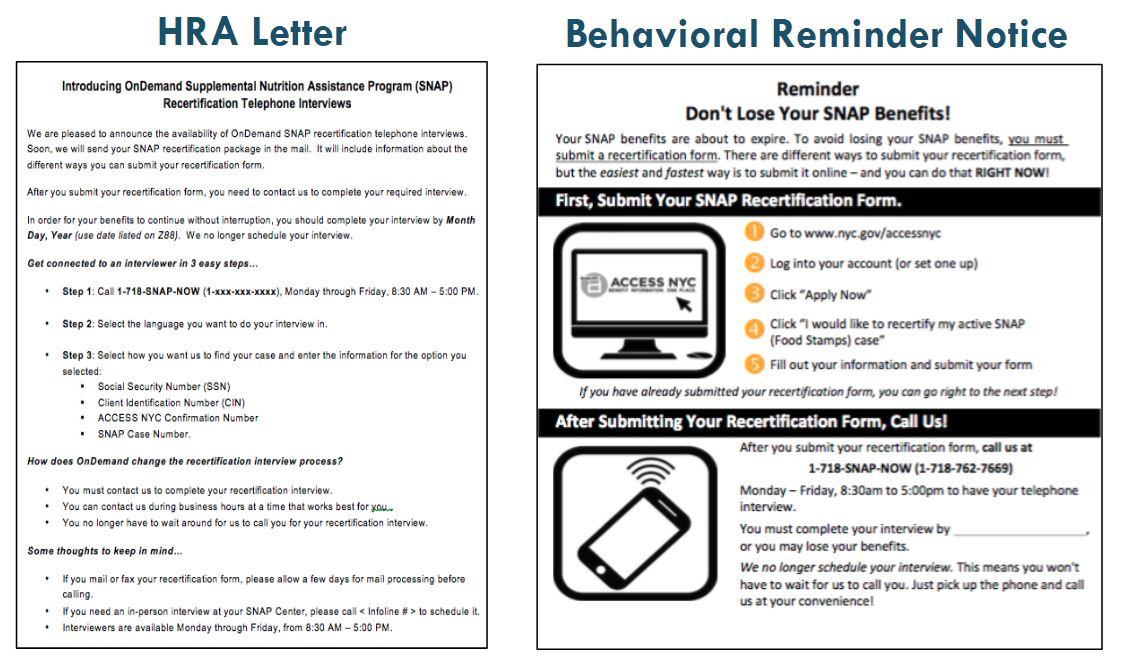
Reminder: Don’t Lose Your SNAP Benefits
Organization : ideas42
Project Overview
Project Summary
The NYC Behavioral Design Team provided an additional reminder to Supplemental Nutrition Assistance Program (SNAP) clients that they would lose their benefits if they did not complete the SNAP recertification process. Highlighting the consequences and including attention-grabbing icons made this NYC BDT supplemental SNAP recertification notice more salient and actionable for clients.
Impact
Clients who received the notice were 5.5 percent less likely to fail to take the first step in the recertification process: submitting the recertification form. Clients who received the notice also submitted their forms earlier: by 45 days into the 75-day recertification period, those who received the notice were 12.9 percent more likely to have already submitted the form.
Challenge
Each month, close to 40,000 SNAP beneficiaries in New York City must take steps to renew their eligibility for SNAP. Unfortunately, 25-30 percent of people do not renew their benefits and lose out on an important safety net and essential food assistance, even though they remain substantively eligible. Most often, clients don’t exit the program because they become ineligible or no longer wish to receive benefits; instead, they fail to complete the required recertification action steps. This means families lose one or more months of benefits, and when they return to the program, they must re-enter as new applications or through an administrative Fair Hearing – processes that are much more burdensome for them and for the city’s Human Resources Administration.
Design
New York City’s Human Resource Administration (HRA) partnered with the Behavioral Design Team to craft a reminder notice to prompt clients to complete the first step of the recertification process: submitting the recertification form. One important element of the notice was to leverage “loss aversion“: reminding people that they would lose their benefits if they did not act, HRA hoped to cut through the information clutter and inspire clients to act quickly to renew their benefits. The new supplemental notice also included large icons that simplified the actionable steps and made them easier to understand and follow.

HRA wanted to both increase the overall number of clients who submitted a recertification form and to increase the number who took this step earlier in the recertification period, to help with logistical challenges of processing the almost 40,000 cases in one month.
Impact
A randomized control trial of 24,000 clients found that those who received the specially-designed supplemental reminder notice were 5.5 percent less likely to fail to submit their recertification form than clients who did not. Recipients of the reminder notice also submitted forms earlier: 45 days into the 75-day recertification period, receivers of the notice were 12.9 percent more likely to have already submitted a recertification form than those in the control group.
People who received the new supplemental reminder notice, which directed them to call for a telephone interview after completing their recertification form, were also 6 percent less likely to conduct their interviews in-person, which reduced costs and administrative burden for HRA.
Researchers estimate that if scaled up to cover all NYC SNAP clients, this reminder notice would lead over 5,000 more people each year to successfully submit a recertification form, the first step to maintain important benefits for themselves and their families.
Implementation Guidelines
Inspired to implement this design in your own work? Here are some things to think about before you get started:
- Are the behavioral drivers to the problem you are trying to solve similar to the ones described in the challenge section of this project?
- Is it feasible to adapt the design to address your problem?
- Could there be structural barriers at play that might keep the design from having the desired effect?
- Finally, we encourage you to make sure you monitor, test and take steps to iterate on designs often when either adapting them to a new context or scaling up to make sure they’re effective.
Additionally, consider the following insights from the design’s researcher:
- Use form submission data to understand when during the recertification period form submission begins to decline. Schedule to have clients receive the notice at approximately this time.
- User test notices to ensure they have the right balance of being official, but still friendly and non-threatening.
- Understand clients’ preferred modes of communication. Ask clients whether they’d like to receive reminders via mail, phone, text, or email.
- After upfront labor costs to set up the notices in the social services mailing system there will be ongoing costs to print and mail reminder letters.
- Writing an email or letter? Be sure to check out B-Hub’s Best Practices Checklist.
Project Credits
Researchers:
Natalie Dabney ideas42
Anthony Barrows ideas42


